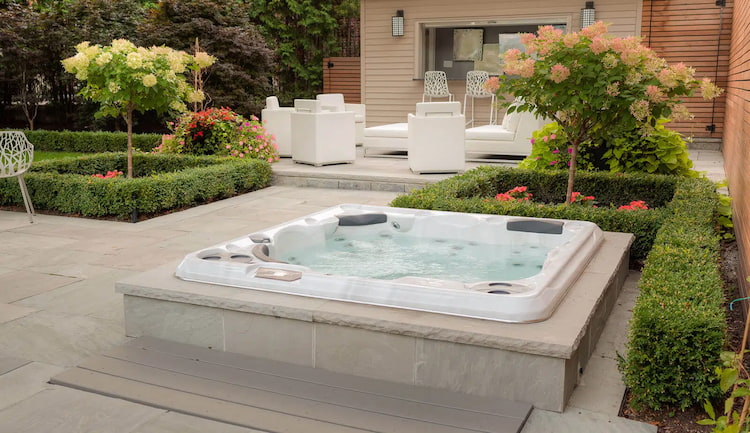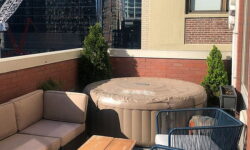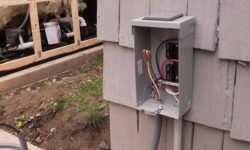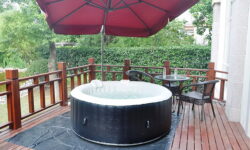Wondering if you can put a hot tub in your basement? You’re not alone. This luxury upgrade can transform your basement into a private spa.
Yes, you can put a hot tub in your basement. However, proper planning and precautions must be taken into account. This includes ensuring the floor can support the weight of the hot tub, adequate ventilation to prevent mold and dampness, and suitable access to plumbing and electrical connections.
Let’s dive in and explore if it’s feasible for you to turn your basement into a relaxing retreat.
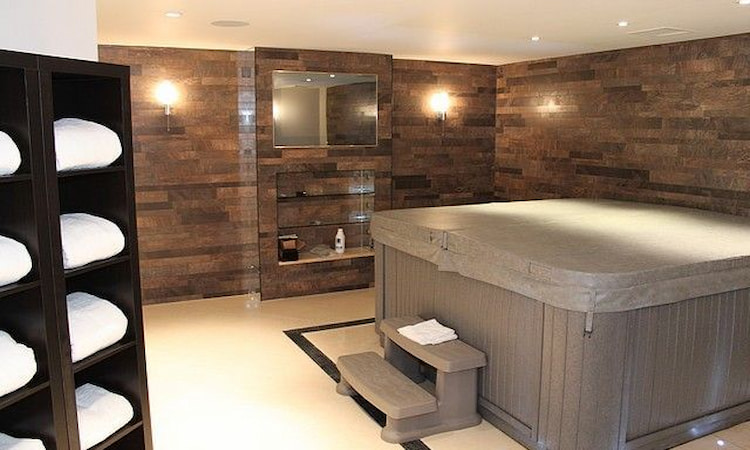
Quick Navigation
Evaluating Your Basement’s Suitability
Before you dive into this project, you’ll need to assess the suitability of your basement for a hot tub. This isn’t a task to take lightly, as several factors will impact your decision.
First, consider the size of your basement. You’ll need ample space not only for the hot tub itself but also for safe and comfortable navigation around it. Take precise measurements, keeping in mind that typical hot tubs are about 6-8 feet in diameter.
Next, evaluate the strength of your basement floor. Hot tubs, when filled, can weigh thousands of pounds, which could potentially damage an inadequately supported floor. Consult with a structural engineer if you’re uncertain about your floor’s capacity to withstand this weight.
Lastly, you’ll need to consider access. Hot tubs are typically delivered as one large piece. Can your basement’s doors or windows accommodate this?
Also, consider the ventilation in your basement. A hot tub generates a lot of heat and humidity, which could lead to mold and mildew issues if not properly ventilated.
Structural Considerations for Hot Tubs
After ensuring your basement’s suitability, it’s time to delve deeper into the structural considerations you’ll need to account for when installing a hot tub.
Careful planning and attention to detail can ensure a successful installation that doesn’t compromise the integrity of your home structure.
The three primary structural aspects you need to consider are the floor, the ceiling, and the walls:
1. Floor
- Load Capacity: Your basement floor must be able to handle the weight of a filled hot tub. Remember, water weighs about 8.3 pounds per gallon, and that’s not including the tub’s weight itself or the occupants.
- Surface: The floor should be flat and stable. You might need to add reinforcement or consider using a self-leveling concrete.
Related Read: How Many Gallons of Water in a Hot Tub?
2. Ceiling
- Height: Your ceiling should be high enough to accommodate the hot tub and allow for comfortable use.
- Ventilation: Proper ventilation is crucial to prevent moisture buildup, which can lead to mold and structural damage.
3. Walls
- Access: Ensure that your basement’s entryway is wide enough to fit the hot tub through.
- Waterproofing: Protect your walls from moisture damage by installing a vapor barrier or using waterproof paint.
Dealing With Humidity and Ventilation
Once you’ve addressed all the structural considerations, you’ll need to tackle another significant challenge – dealing with the high levels of humidity and ensuring proper ventilation in your basement.
Hot tubs produce a lot of moisture, which can lead to mold and mildew if not properly managed. You’ll need a robust ventilation system to prevent these issues.
To handle this, consider three key factors: a dehumidifier, an exhaust fan, and proper air circulation. Below is a table to help you understand these aspects:
| Factor | Function | Importance |
|---|---|---|
| Dehumidifier | Removes excess moisture | Prevents damage to walls, floors |
| Exhaust Fan | Extracts humid air | Stops condensation build-up |
| Air Circulation | Distributes air evenly | Keeps humidity levels balanced |
A dehumidifier is essential to absorb surplus moisture. An exhaust fan, preferably with a timer or humidity sensor, can help to expel damp air outside, reducing condensation.
Lastly, adequate air circulation ensures an even distribution of heat and humidity, preventing damp spots.
Installation Process and Challenges
Now that you’ve tackled the issues of humidity and ventilation, the actual installation process of your basement hot tub presents its own set of challenges.
First, you need to make sure your basement floor can support the weight of a full hot tub. This includes not only the tub itself but also the water and the people in it. If you’re not sure, it’s best to consult a structural engineer.
Here are some other challenges you’ll likely face:
Access and Maneuverability: most hot tubs are large and bulky, making them difficult to maneuver into a basement. You might need to remove doors or even walls to get the tub into your basement.
Plumbing and Electrical Work: the hot tub will need a dedicated electrical circuit. If you’re not experienced with electrical work, you’ll need to hire an electrician. Plumbing can be tricky, too. You’ll need to consider how to drain the tub and where to route the water.
Soundproofing: the noise from the hot tub’s pump and heater can be disruptive. Consider installing soundproofing materials to minimize noise.
Maintenance of Basement Hot Tubs
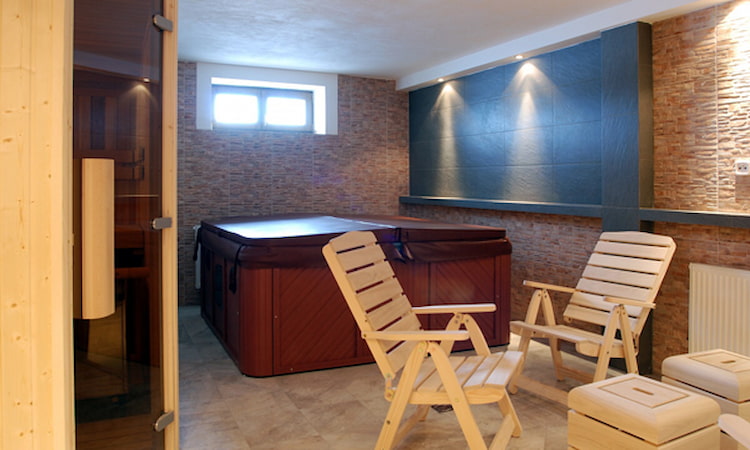
Beyond the installation hurdles, maintaining your basement hot tub is an essential step you can’t ignore. Regular upkeep ensures your hot tub’s longevity and functionality.
Firstly, you must balance the water chemistry. This involves testing, and then adjusting the pH, alkalinity, and sanitizer levels. Doing so not only keeps the water clean but also prevents damage to the tub’s components.
Secondly, cleaning your hot tub’s filter is crucial. A clogged or dirty filter can impair water circulation and lead to murky water or even damage your hot tub’s pump. It’s recommended to clean the filter every two weeks and replace it annually.
The water in your tub should also be completely drained and replaced every three to four months. This helps to prevent the buildup of bacteria and other contaminants.
Related Read: How to Clean Hot Tub Water Without Draining?
Lastly, always be on the lookout for any signs of wear and tear. This includes cracks, leaks, or malfunctioning jets. If you notice any issues, it’s best to call a professional for repairs immediately to prevent further damage.
Frequently Asked Questions
Installing a hot tub in your basement could offer health benefits. It can aid in stress relief, muscle relaxation, and improved sleep. It’s also beneficial for arthritis and can boost cardiovascular health.
Yes, you can, but it’s often more costly. Indoor installations require additional ventilation and structural support. Outdoor setups are typically cheaper unless you’re adding a deck or patio specifically for the tub.
Yes, some hot tub brands are better suited for basement installation. Look for models with efficient insulation, compact design, and easy maintenance. Brands like Jacuzzi, Hot Springs, and Sundance are worth considering.
When considering energy consumption, having a hot tub in your basement might increase your energy bill. It’s essential to choose energy-efficient models and ensure proper insulation to minimize heat loss and maintain lower costs.
Yes, you can move your hot tub from the basement to another location in the future. It’ll require some planning and potentially professional help, due to the unit’s size, weight, and plumbing requirements.
Conclusion
Yes, you can install a hot tub in your basement, but remember it’s not as simple as it sounds. Consider your basement’s structural integrity, cope with humidity, and ensure proper ventilation.
The installation process may pose some challenges, but with careful planning, it’s achievable. Regular maintenance is crucial to keep your basement hot tub in top shape. Dive into your research, plan meticulously, and enjoy the soothing comfort of a basement hot tub.


![Can You Put a Hot Tub on Pavers? [Pros & Cons] can you put your hot tub on pavers](https://hottubtales.com/wp-content/uploads/2023/10/can-you-put-your-hot-tub-on-pavers-250x150.jpg)
